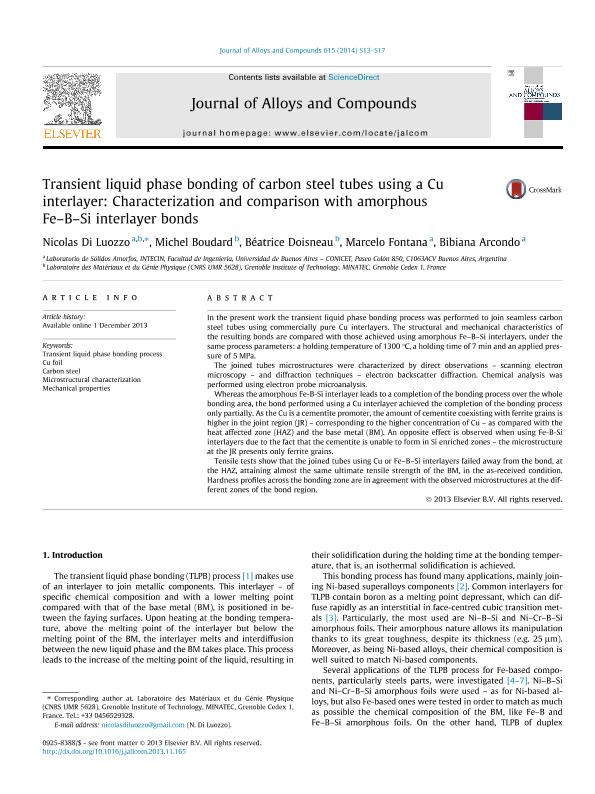Mostrar el registro sencillo del ítem
dc.contributor.author
Di Luozzo, Nicolás

dc.contributor.author
Boudard, Miguel Santiago

dc.contributor.author
Doisneau, Béatrice
dc.contributor.author
Fontana, Marcelo

dc.contributor.author
Arcondo, Bibiana Graciela

dc.date.available
2017-12-15T20:25:29Z
dc.date.issued
2013-12
dc.identifier.citation
Arcondo, Bibiana Graciela; Fontana, Marcelo; Doisneau, Béatrice; Boudard, Miguel Santiago; Di Luozzo, Nicolás; Transient liquid phase bonding of carbon steel tubes using a Cu interlayer: Characterization and comparison with amorphous Fe–B–Si interlayer bonds; Elsevier; Journal of Alloys and Compounds; 615; Sup. 1; 12-2013; 13-17
dc.identifier.issn
0925-8388
dc.identifier.uri
http://hdl.handle.net/11336/30835
dc.description.abstract
In the present work the transient liquid phase bonding process was performed to join seamless carbon steel tubes using commercially pure Cu interlayers. The structural and mechanical characteristics of the resulting bonds are compared with those achieved using amorphous Fe–B–Si interlayers, under the same process parameters: a holding temperature of 1300 °C, a holding time of 7 min and an applied pressure of 5 MPa.
The joined tubes microstructures were characterized by direct observations – scanning electron microscopy – and diffraction techniques – electron backscatter diffraction. Chemical analysis was performed using electron probe microanalysis.
Whereas the amorphous Fe-B-Si interlayer leads to a completion of the bonding process over the whole bonding area, the bond performed using a Cu interlayer achieved the completion of the bonding process only partially. As the Cu is a cementite promoter, the amount of cementite coexisting with ferrite grains is higher in the joint region (JR) – corresponding to the higher concentration of Cu – as compared with the heat affected zone (HAZ) and the base metal (BM). An opposite effect is observed when using Fe-B-Si interlayers due to the fact that the cementite is unable to form in Si enriched zones – the microstructure at the JR presents only ferrite grains.
In the present work the transient liquid phase bonding process was performed to join seamless carbon steel tubes using commercially pure Cu interlayers. The structural and mechanical characteristics of the resulting bonds are compared with those achieved using amorphous Fe–B–Si interlayers, under the same process parameters: a holding temperature of 1300 °C, a holding time of 7 min and an applied pressure of 5 MPa. The joined tubes microstructures were characterized by direct observations – scanning electron microscopy – and diffraction techniques – electron backscatter diffraction. Chemical analysis was performed using electron probe microanalysis. Whereas the amorphous Fe-B-Si interlayer leads to a completion of the bonding process over the whole bonding area, the bond performed using a Cu interlayer achieved the completion of the bonding process only partially. As the Cu is a cementite promoter, the amount of cementite coexisting with ferrite grains is higher in the joint region (JR) – corresponding to the higher concentration of Cu – as compared with the heat affected zone (HAZ) and the base metal (BM). An opposite effect is observed when using Fe-B-Si interlayers due to the fact that the cementite is unable to form in Si enriched zones – the microstructure at the JR presents only ferrite grains. Tensile tests show that the joined tubes using Cu or Fe–B–Si interlayers failed away from the bond, at the HAZ, attaining almost the same ultimate tensile strength of the BM, in the as-received condition. Hardness profiles across the bonding zone are in agreement with the observed microstructures at the different zones of the bond region.
dc.format
application/pdf
dc.language.iso
eng
dc.publisher
Elsevier

dc.rights
info:eu-repo/semantics/openAccess
dc.rights.uri
https://creativecommons.org/licenses/by-nc-nd/2.5/ar/
dc.subject
Transient Liquid Phase Bonding Process
dc.subject
Cu Foil
dc.subject
Carbon Steel
dc.subject
Microstructural Characterization
dc.subject
Mechanical Properties
dc.subject.classification
Otras Ciencias Químicas

dc.subject.classification
Ciencias Químicas

dc.subject.classification
CIENCIAS NATURALES Y EXACTAS

dc.title
Transient liquid phase bonding of carbon steel tubes using a Cu interlayer: Characterization and comparison with amorphous Fe–B–Si interlayer bonds
dc.type
info:eu-repo/semantics/article
dc.type
info:ar-repo/semantics/artículo
dc.type
info:eu-repo/semantics/publishedVersion
dc.date.updated
2017-12-15T14:56:55Z
dc.journal.volume
615
dc.journal.number
Sup. 1
dc.journal.pagination
13-17
dc.journal.pais
Países Bajos

dc.journal.ciudad
Ámsterdam
dc.description.fil
Fil: Di Luozzo, Nicolás. Universidad de Buenos Aires. Facultad de Ingenieria. Departamento de Fisica. Laboratorio de Sólidos Amorfos; Argentina. Consejo Nacional de Investigaciones Científicas y Técnicas. Oficina de Coordinación Administrativa Houssay. Instituto de Tecnologías y Ciencias de la Ingeniería "Hilario Fernández Long". Universidad de Buenos Aires. Facultad de Ingeniería. Instituto de Tecnologías y Ciencias de la Ingeniería "Hilario Fernández Long"; Argentina
dc.description.fil
Fil: Boudard, Miguel Santiago. Institut Politechnique de Grenoble; Francia
dc.description.fil
Fil: Doisneau, Béatrice. Institut Politechnique de Grenoble; Francia
dc.description.fil
Fil: Fontana, Marcelo. Universidad de Buenos Aires. Facultad de Ingenieria. Departamento de Fisica. Laboratorio de Sólidos Amorfos; Argentina. Consejo Nacional de Investigaciones Científicas y Técnicas. Oficina de Coordinación Administrativa Houssay. Instituto de Tecnologías y Ciencias de la Ingeniería "Hilario Fernández Long". Universidad de Buenos Aires. Facultad de Ingeniería. Instituto de Tecnologías y Ciencias de la Ingeniería "Hilario Fernández Long"; Argentina
dc.description.fil
Fil: Arcondo, Bibiana Graciela. Universidad de Buenos Aires. Facultad de Ingenieria. Departamento de Fisica. Laboratorio de Sólidos Amorfos; Argentina. Consejo Nacional de Investigaciones Científicas y Técnicas. Oficina de Coordinación Administrativa Houssay. Instituto de Tecnologías y Ciencias de la Ingeniería "Hilario Fernández Long". Universidad de Buenos Aires. Facultad de Ingeniería. Instituto de Tecnologías y Ciencias de la Ingeniería "Hilario Fernández Long"; Argentina
dc.journal.title
Journal of Alloys and Compounds

dc.relation.alternativeid
info:eu-repo/semantics/altIdentifier/url/http://www.sciencedirect.com/science/article/pii/S092583881302906X
dc.relation.alternativeid
info:eu-repo/semantics/altIdentifier/doi/http://dx.doi.org/10.1016/j.jallcom.2013.11.165
Archivos asociados
